|
|
 |
|
Calanoida ( Order ) |
|
|
|
Clausocalanoidea ( Superfamily ) |
|
|
|
Aetideidae ( Family ) |
|
|
|
Euchirella ( Genus ) |
|
|
| |
Euchirella amoena Giesbrecht, 1888 (F,M) | |
| | | | | | | Syn.: | Euchirella amöna Giesbrecht, 1892 (p.233, 244, 772, fig.M); Rose, 1929 (p.21, figs.M, Rem.);
Euchirella brevis Sars, 1905 (p.12); Wolfenden, 1905 a (p.18, figs.F); 1911 (p.236, figs.F); Sars, 1925 (p.71, figs.F); Farran, 1929 (p.208, 234, Rem.); Rose, 1929 (p.21, figs.M); Sewell, 1929 (p.107, 109); Rose, 1933 a (p.105, figs.F); Wilson, 1936 c (p.90); Wilson, 1942 a (p.185); Lysholm & al., 1945 (p.17); Sewell, 1947 (p.69); 1948 (p.348, 500, 520, 545, 556, 566); C.B. Wilson, 1950 (p.221); Brodsky, 1950 (1967) (p.177, figs.F); Vervoort, 1952 f (n°47, p.3, figs.F); Ganapati & Shanthakumari, 1962 (p.8, 15); Fagetti, 1962 (p.19); Björnberg, 1963 (p.37); Vives, 1972 (p.211, figs.F); Björnberg, 1973 (p.324, 386); Tranter, 1977 (p.598); Vives, 1982 (p.291); Shih & Young, 1995 (p.67); Ikeda & al., 2006 (p.1791, Table 2);
E. bella : C.B. Wilson, 1950 (part., p.218, fig.M, no F) | | | | Ref.: | | | Giesbrecht & Schmeil, 1898 (p.36, Rem. M); Esterly, 1905 (p.155, figs.M); A. Scott, 1909 (p.53); Mori, 1937 (1964) (p.42, figs.F,M); Brodsky, 1950 (1967) (p.175, figs.M); Vervoort, 1952 f (n°47, p.3, fig.M, Rem.); Chiba, 1956 (p.33, figs.M, juv.M); 1957 a (p.11); Fish, 1962 (p.21, fig.M); Grice, 1962 (p.194, figs.F,M, Rem.); Vervoort, 1963 b (p.135, Rem.); Owre & Foyo, 1967 (p.46, figs.F,M); Park, 1968 (p.550, Rem.F,M); Tanaka & Omori, 1969 (p.37, Rem.); Kos, 1972 (Vol. I, figs.F,M, Rem.); Vaupel-Klein, 1972 (p.501, figs.F,M); Park, 1976 a (p.107, figs.F,M); Bradford & Jillett, 1980 (p.33, figs.F,M, fig. 73, distribution chart); Björnberg & al., 1981 (p.605, 632, fig.F); Zheng & al., 1982 (p.33, figs.F); Vaupel Klein, 1984 a (p.36, figs.F, Table II: characters); Zheng Zhong & al., 1984 (1989) (p.235, figs.F,M); Markhaseva, 1996 (p.147, figs.F,M); Chihara & Murano, 1997 (p.685, Pl. 36,40: F,M); Bradford-Grieve & al., 1999 (p.879, 921, figs.F,M); Conway & al., 2003 (p.174, figs.F,M, Rem.) |  issued from : T. Park in Contr. Mar. Sci., 1976, 20. [p.108, Fig.1] Female: a, b, habitus (dorsal and lateral, respectively); c, d, posterior part of metasome and urosome (dorsal and lateral, respectively); e, A2; f, Md; g, coxa of fourth leg (posterior). Male: h, i, forehead (dorsal and lateral, respectively); j, fifth pair of legs (anterior); k, exopod of right fifth leg (anterior); l, exopod of left fifth leg (anterior).
|
 Issued from : G.O. Sars in Résult. Camp. Scient. Prince Albert I, 69, pls.1-127 (1924). [Pl.XXI, figs.1-7]. As Euchirella brevis. Female: 1, habitus with eggs (dorsal); 2, idem (lateral left side); 3, forehead (lateral); 4, A2; 5, Md; 6, basipodal segment of P4; 7, inner end of 1st basdipodal segment of P4.
|
 issued from : R.N. Wolfenden in Die Marinen Copepoden der Deutschen Südpolar-Expedition 1901-1903, 1911. [p.236, Fig.21]. As Euchirella brevis. Female: a, postrior part cephalothorax and urosome (lateral, left side); b, A2; c, Md (mandibular palp); d, Mx1; e, basal portion of Mxp; f, P1; g, basal segment of P4.
|
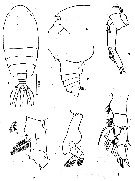 issued from : Z. Zheng, S. Li, S.J. Li & B. Chen in Marine planktonic copepods in Chinese waters. Shanghai Sc. Techn. Press, 1982 [p.34, Fig.19]. Female: a, habitus (dorsal); b, forehead (lateral); c, urosome (lateral, right side); d, Md; e, A2; f, P1; g, basipodal segments 1 and 2 of P4. Scale bar in mm.
|
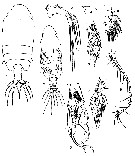 issued from : T. Mori in The pelagic Copepoda from the neighbouring waters of Japan, 1937 (2nd edit., 1964). [Pl.18, Figs.1-9]. Female: 1, habitus (dorsal); 3, A2; 4, forehead (lateral); 5, P1; 9, A1. Male: 2, habitus (dorsal); 6, P2; 7, P5; 8, P4.
|
 issued from : J.C. von Vaupel Klein in Crustaceana, Supplt 9, Studies on Copepoda, III, 1984. [p.74, Fig.12, d]. Female: d, setal armature of exopod of Mx1 (left one in posterior aspect; all setae are plumose). Nota: 10 setae condition (see E. formosa p.74, fig.12 a). Nota: 8 setae-condition.
|
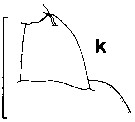 issued from : J.C. von Vaupel Klein in Crustaceana, Supplt 9, Studies on Copepoda, III, 1984. [p.63, Fig.5, k]. Female: k, setal armature of basipodite 2 of A2 (note: no seta present). Scale bar 0.1 mm.
|
 issued from : C.O. Esterly in Univ. Calif. Publs Zool., 1905, 2 (4). [p.155, Fig.21]; Male (from San Diego Region): a, habitus (lateral); b, P5. Nota: Head without crest.
|
 issued from : C.B. Wilson in Bull. U.S. natn Mus., 100, 14 (4). [Pl.8, Fig.84]. As Euchirella bella. Male (from Pacific): 84, P5.
|
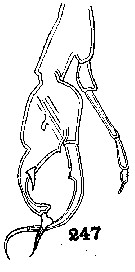 issued from : C.B. Wilson in Bull. U.S. natn Mus., 100, 14 (4). [Pl.19, Fig.247]. As Euchirella bella. Male (from Pacific): 247, P5.
|
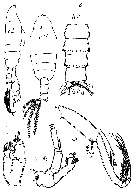 issued from : M. Rose in Result. Camp. Scient. Prince Albert Ier, Monaco, 1929, 78. [Pl. I, Figs.3]. As Euchirella amöna. Male (from 31°08'N23°58'W): D', habitus (dorsal); L', idem (lateral); Ab', urosome (dorsal); A'2, A2; p, Md (mandibular palp); Mxp (as Mxp'2).
|
 issued from : M. Rose in Result. Camp. Scient. Prince Albert Ier, Monaco, 1929, 78. [Pl. I, Figs.3]. As Euchirella amöna. Male: A'1, A1; P1 to P4; P5; ted, terminal segment of exopodite of right P5; teg, terminal segment of left P5.
|
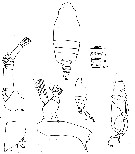 issued from : G.D. Grice in Fish. Bull. Fish and Wildl. Ser., 1962, 61. [p.195, Pl.10, Figs.5-10]. Female (from equatorial Pacific): 5, A2; 6, Md; 7, 1st basipodal segment of P4. Male: 8-9, (dorsal and lateral, respectively); 10, P5.
|
 issued from : J.C. von Vaupel Klein in Crustaceana, Supplt 9, Studies on Copepoda, III, 1984. [p.80, Fig.16, s]. Female: o, arrangement of medial spines on the posterior face of basal segment 1 of left P4 . Scale bar 0.067 mm. Nota: 5 minute, separately inserting, subequal spines.
|
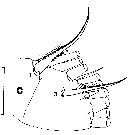 issued from : J.C. von Vaupel Klein in Crustaceana, Supplt 9, Studies on Copepoda, III, 1984. [p.69, Fig.9, c]. Female: c, setal armature on the posterior face of the 1st inner lobe of basipodal segment 1 of left Mx1 (2 setae, numbered 1 to 2 in a proximal to distal order to compare other species, here setae 2 and 4 absent contrary with 4 setae in E. rostrata. Scale bar: 0.1 mm.
|
 issued from : J.C. von Vaupel Klein in Crustaceana, Supplt 9, Studies on Copepoda, III, 1984. [p.65, Fig.6 g]. Euchirella anoena: a, Setal armature of endopodte 2+3 of A2. Conditions are expressed are expressed in formulae as follows: number of setae in regular row on proximal lobe / relative development of seta in position no. 9 on this lobe / number of setae in approximately linear row on terminal lobe / relative development of appendicular seta no. 7 and its supporting pedestral (absent, vestigial, moderate or well developed: see Table I, p.87 and Table II, p.93). upper and lower lobes = proximal and terminal lobes (details of right appendage shown in medial aspect. Scale bar = 0.133 mm. Nota: Condition 1/1/3/0 in the amoena-group.
|
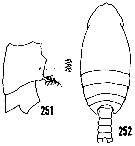 issued from : H.B. Owre & M. Foyo in Fauna Caribaea, 1967, 1, Crustacea, 1: Copepoda. [p.46, Figs.251, 252]. Female (from Florida Current): 251, basipodite 1 (= coxa) of P4. Nota: Cxa of P4 with 4 minute spines on the inner margin. Male: 252, habitus (dorsal).
|
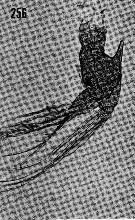 issued from : H.B. Owre & M. Foyo in Fauna Caribaea, 1967, 1, Crustacea, 1: Copepoda. [p.47, Fig.256]. Female (from Florida Current): 256, Md (mandibular palp).
|
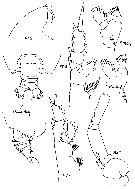 Issued from : E.L. Markhaseva in Proc. Zool. Inst., RAN, 1996, 268. [p.148, Fig.112]. Female (from 17°N, 18°W).
|
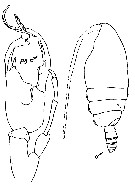 Issued from : E.L. Markhaseva in Proc. Zool. Inst., RAN, 1996, 268. [p.148, Fig.112]. After Bradford & Jillett, 1980. Male: P5; habitus (lateral). Nota male from Marhhaseva (1996, p.149) after Tanaka & Omori (1969) with modifications: Crest present, very low. Exupodal segment 2 of A2 with 6 setae on each lobe. P5 biramous. Endopod of left P5 rudimentary, not reaching proximal border of right protopodite. Endopod of right P5 with 4 (in original specimen with 3) projections, exopod also with 4 projections.
|
 Euchirella amoena Euchirella amoena female: 1 - Genital segment symmetrical. 2 - Crest absent. Rostrum not rudimentary. 3 - Md palp base with chitinous projection. Coxopodite of P4 with 5 very poorly visible small spines. Endopodal segment 2 of A2 with 3 setae on external lobe and 1 seta on internal lobe. Rostrum small.
|
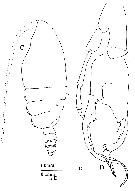 Issued from : J.M. Bradford & J.B. Jillett inNew Zealand Ocean. Inst. Memoir, 86, 1980. [p.33, Fig.19]. Male (from off N New Zealand): C, habitus (lateral); D, P5. Nota: Exopodal segment 1 of right P5 with stout spine at midlength.
|
 Euchirella amoena Euchirella amoena male: 1 - P5 uniramous on left P5 and large biramous on right P5. Exopodal segment 2 and endopod of right P5 elongated and sharpened in their distal parts forming tongs. Endopod of right P5 significantly exceeding distal border of exopodal segment 1 of right P5. Crest absent. Robust spine present near place where from exopod of right P5 begins.
|
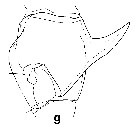 issued from : J.C. von Vaupel Klein in Crustaceana, Supplt 9, Studies on Copepoda, III, 1984. [p.68, Fig.8, g]. Euchirella amoena: Structure and setal armature of basipode 2 (right appendage in lateral aspect). With prominent, hook-shaped outgrowth.
|
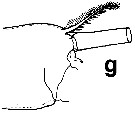 Issued from : J.C. von Vaupel Klein in Crustaceana, Supplt 9, Studies on Copepoda, III, 1984. [p.70, Fig.10, g]. Euchirella amoena: Setal armature on proximo-distal corner of basis (Ba2), adjacent to the endopod (Ri) of Mx1 (left appendage in postrior view; secondary structures on large setae are not shown, and neither are the hairs on the basis proper). Only 1 small seta present, as in Euchirella bella (Fig.10h).
|
 Issued from : J.C. von Vaupel Klein in Crustaceana, Supplt 9, Studies on Copepoda, III, 1984. [p.72, Fig.11, b]. Euchirella amoena. Structure of Mx1, terminal configuration of setae plus the 'blunt tooth (= tubular pore) on the endite of basis (Ba2) (plumosity and/or spinules on setae, as well as hairs on lobe, omitted, right appendage in anterior view). Showing the usual Euchirella complement of, from anterior to posterior: short proximal seta (p), long central seta (c), blunt tooth (dotted outline) and shortest, distal seta (d). Contrary to E. curticauda the proximal seta (p) absent in E. amoena.
|
 Issued from : J.C. von Vaupel Klein in Crustaceana, (Supplement) 9, 1984. [p.93, Table II ]. Euchirella amoena Female: Datamatrix stating observed states of characters from Table I (p.87-90) presently examined; nos. refer to the input nos. used in Table I (see to the family Aetideidae).
|
 Issued from : J.C. von Vaupel Klein in Crustaceana, (Supplement) 9, 1984. [p.94, Table II (cont' d) ]. Euchirella amoena Female: Datamatrix stating observed states of characters from Table I (p.87-90) presently examined; nos. refer to the input nos. used in Table I (see to the family Aetideidae).
|
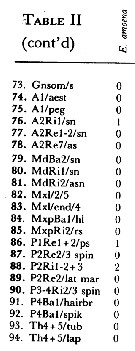 Issued from : J.C. von Vaupel Klein in Crustaceana, (Supplement) 9, 1984. [p.95, Table II (cont' d) ]. Euchirella amoena Female: Datamatrix stating observed states of characters from Table I (p.87-90) presently examined; nos. refer to the input nos. used in Table I (see to the family Aetideidae).
| | | | | Compl. Ref.: | | | Sewell, 1948 (p.348, 500, 545, 550, 551, 556, 562); Chiba & al., 1957 (p.308); Yamazi, 1958 (p.148, Rem.); Grice, 1963 a (p.495); De Decker & Mombeck, 1964 (p.12); Grice & Hulsemann, 1965 (p.223); 1967 (p.15); Fleminger, 1967 a (tabl.1); Morris, 1970 (p.2300); Roe, 1972 (p.277, tabl.1, tabl.2); Carter, 1977 (1978) (p.35); Deevey & Brooks, 1977 (p.256, tab.2, Station "S"); Vives, 1982 (p.291, as amoeba); Dessier, 1983 (p.89, Tableau 1, Rem., %); Guangshan & Honglin, 1984 (p.118, tab.); Stephen, 1984 (p.161, 169, Distribution vs thermocline & geographic); Cummings, 1984 (p.163, Table 2); Greze & al., 1985 (p.7); Madhupratap & Haridas, 1986 (p.105, tab.1); Lozano Soldevilla & al., 1988 (p.58); Cervantes-Duarte & Hernandez-Trujillo, 1989 (tab.3); Heinrich, 1990 (p.17); Suarez & al., 1990 (tab.2); Suarez & Gasca, 1991 (tab.2); Hernandez-Trujillo, 1991 (1993) (tab.I); Suarez, 1992 (App.1); Shih & Young, 1995 (p.67); Suarez-Morales, 1998 (p.345, Table 1); Suarez-Morales & Gasca, 1998 a (p107); Lopez-Salgado & al., 2000 (tab.1); Lapernat, 2000 (tabl.3, 4); Hsiao & al., 2004 (p.325, tab.1); Pusch & al., 2004 (251, tab.3); Zuo & al., 2006 (p.162: tab.1); Hwang & al., 2006 (p.943, tab.I); Hwang & al., 2007 (p.23); Dur & al., 2007 (p.197, Table IV); Humphrey, 2008 (p.83: Appendix A); Neumann-Leitao & al., 2008 (p.799: Tab.II, fig.6); Morales-Ramirez & Suarez-Morales, 2008 (p.517); Fernandes, 2008 (p.465, Tabl.2); Muelbert & al., 2008 (p.1662, Table 1: as amoens); Schnack-Schiel & al., 2010 (p.2064, Table 2: E Atlantic subtropical/tropical); Hidalgo & al., 2010 (p.2089, Table 2); Hsiao S.H. & al., 2011 (p.475, Appendix I); DiBacco & al., 2012 (p.483, Table S1, ballast water transport); Takenaka & al., 2012 (p.1669, fig.2, 3, Table 1, bioluminescence); Hidalgo & al., 2012 (p.134, Table 2) ; in CalCOFI regional list (MDO, Nov. 2013; M. Ohman, comm. pers.); Lidvanov & al., 2013 (p.290, Table 2, % composition); Jerez-Guerrero & al., 2017 (p.1046, Table 1: temporal occurrence) | | | | NZ: | 19 | | |
|
Distribution map of Euchirella amoena by geographical zones
|
| | | | | | | | | | | |  Issued from : J.M. Bradford & J.B. Jillett in New Zealand Ocean. Inst. Memoir, 86, 1980. [p.88-89, Figs.65-67]. Issued from : J.M. Bradford & J.B. Jillett in New Zealand Ocean. Inst. Memoir, 86, 1980. [p.88-89, Figs.65-67].
Distribution of several species of Euchirella in the Tasman Sea and around New Zealand.
Nota: Euchirella indica (= Euchirella massinensis indica). |
| | | | Loc: | | | South Africa (E), off St. Helena Is. (SW & N), off Ascension Is., G. of Guinea, Cape Verde Is., off NW Cape Verde Is., off Morocco-Mauritania, Great Meteor Seamount, Canary Is., off Madeira, Azores, off Bay of Biscay, Uruguay (continental shelf), S Brazil, off Amazon, Venezuela, G. of Mexico, Yucatan, Barbada Is., Caribbean, Cuba, Florida, off Bermuda: Station "S" (32°10'N, 64°30'W), Sargasso Sea, Iceland, off N Scotland, Ibero-moroccan Bay, Medit. (Alboran Sea), off SW Sri Lanka, Natal, Indian, India (Lawson's Bay), Bay of Bengal, Andaman Sea, W Australia, Indonesia-Malaysia, Philippines, Pacif. (equatorial), Pacific (central gyres: N and S), Bikini Is., China Seas (East China Sea, South China Sea), Taiwan (SW, N, E), Japan, S. Hokkaido, SW Bering Sea, Alaska, Pacif. (central subtropical N), off S Clipperton Is., California, W Baja California, W Costa Rica, Bahia Cupica (Colombia); off Peru, off Galapagos, Pacif. (W equatorial), Australia, New Zealand, Pacif. (SE tropical), Chile (N-S, off Santiago).
Type locality: Pacific (equatorial). | | | | N: | 108 (S Atlant.: 14; N Atlant.: 32; Medit.: 33; Red Sea: 1; Indian: 13, Pacif.: 14) | | | | Lg.: | | | F: (1) F: 3,9; (14) F: 3,5-2,7; M: 3,3; (22) F: 3,9; (35) F: 3,96; (37) F: 4-2,7; M: 3,85-3; (47) M: 3,35; (72) F: 3,84-3,74; M: 3,55-3,2; (101) F: 3,8-3,7; M: 3,33-3,2; (110) F: 4; M: 3,67-3,4; (142) M: 3,02; (199) F: 3,72-3,34; M: 3,34-3,04; (202) F: 3; M: 2,9; (235) F: 3,72-3,04; M: 3,36-3,08; (237) F: 3; M: 2,9; (238) F: 3,65; (785) M: 3,63; (991) F: 2,7-4; M: 3-3,85; (1023) F: 3,96; (1257) F: 3,25-3,55; {F: 2,70-4,00; M: 2,90-3,85}
The mean female size is 3.5395 mm (n = 22; SD = 0.4649), and the mean male size is 3.2985 mm (n = 20; SD = 0.2944). The size ratio (male : female) is 0.955 (n = 10; SD = 0.0668). | | | | Rem.: | epipelagic-? bathypelagic. Sargasso Sea: 1000-1500 m (Deevey & Brooks, 1977, station "S");
According to Grice (1962, p.196) Fleminer (1956) is no doubt correct in placing Sars' (1905) brevis (described from female) in synonymy with Giesbrecht's (1888) amoena (described from a male).
See in DVP Conway & al., 2003 (version 1)
R. Stephen: Data sheets of NIO, Kochi, India (on line). | | | Last update : 19/06/2023 | |
|
|
 Any use of this site for a publication will be mentioned with the following reference : Any use of this site for a publication will be mentioned with the following reference :
Razouls C., Desreumaux N., Kouwenberg J. and de Bovée F., 2005-2025. - Biodiversity of Marine Planktonic Copepods (morphology, geographical distribution and biological data). Sorbonne University, CNRS. Available at http://copepodes.obs-banyuls.fr/en [Accessed December 02, 2025] © copyright 2005-2025 Sorbonne University, CNRS
|
|
 |
 |




























